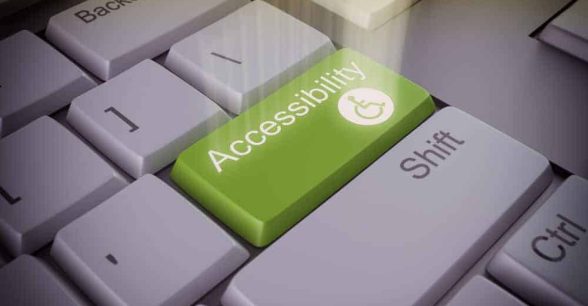The COVID-19 Pandemic Makes it Clear: It’s Time to Permanently Close Institutions
The following post is part of our series on perspectives from disabled and chronically ill people regarding COVID-19. Content note: institutionalization
I was born into what is called the “ADA Generation.” For my entire life, the Americans with Disabilities Act (ADA) has been the law of the land, protecting the rights of people with disabilities. One of those rights is the right to live in the community instead of being forced to live in institutions. Some people might think this means institutions are a thing of the past for people with disabilities. As a survivor of institutions, I know that institutions are still alive and well today, and millions of people with disabilities in the U.S. are still warehoused within their walls. And the people living and working in institutions, alongside survivors of institutions who now live in the community, have been especially impacted by the ongoing COVID-19 crisis. This pandemic has shown that, even though it’s been 30 years since the passage of the ADA, institutions are still just as harmful to people with disabilities today.
Institutions are a perfect environment for the spread of a disease like COVID-19. The amount of staff in most institutions is not sufficient for each person living there to receive individual care. I know from my experience in institutions that none of us were allowed to be alone for an extended period of time, and most of the day was spent in one room as a large group. These conditions are commonplace for many institutions, making it impossible to self-isolate.
Last year, regular inspections of nursing homes found that over half were cited for failures to control infections, such as the flu and pneumonia, which paints a grim picture for their ability to control the spread of a highly infectious disease like the coronavirus. On top of this, some institutions are not supplying staff with personal protective equipment (PPE), like masks and gloves. That means that staff may be spreading COVID-19 between the people they work with, even if individuals are able to stay mostly within their own rooms.
We know from the numbers released so far that COVID-19 has hit institutions especially hard, putting what is already a medically vulnerable population even further at risk. Data tracked by the Autistic Self Advocacy Network found that over 60,000 cases of COVID-19 in U.S. institutions have been confirmed so far, and of those cases, over 10,000 have died. About 63,000 people have died in the U.S. due to COVID-19 – which means that about 1 in 6 COVID-related deaths came from institutions.
On top of these numbers, individual cases are pouring in of staff reporting COVID-19 outbreaks within their workplaces and detailing unsafe working conditions that might be contributing to these outbreaks. Staff members at institutions are often paid barely above minimum wage, and some also have health conditions that put them in a high-risk category should they contract COVID-19. They may feel it necessary to quit their jobs rather than keep working in such a dangerous environment. The resulting staff shortages put people living in institutions in even more danger.
Institutions isolate people with disabilities from the rest of society, which is one reason why many people might not even know that institutions still exist. That isolation is also another reason institutions can be so dangerous: if people with disabilities get neglected or abused in institutions, there may be no way for others to find out. Right now, some institutions are refusing to let anyone know details about COVID-19 outbreaks, such as how many people are affected or what safety measures are being put in place – not even the family members of the people with disabilities living there.
While the Centers for Medicare & Medicaid Services mandated that nursing homes must share data about how many people have contracted COVID-19, this mandate doesn’t apply to all institutions. Institutions for people with intellectual and developmental disabilities, psychiatric institutions, and small institutions like group homes can still choose not to share this information. Outside of what is required by the federal government, each state has widely different protocols about which institutions must share data on COVID-19, as well as what data specifically must be shared. That means that we still don’t have the full picture as to how many individuals in institutions have been impacted by COVID-19. What’s more, inspections of nursing homes have been halted due to the coronavirus – during a time when this information is needed most.
Many institutions are also prohibiting family member visits as the pandemic continues, leaving families in the dark about how their loved ones are doing, contributing even more anxiety to what is already a high-stress situation. While this may seem on the surface to be an appropriate safety measure, for some people with disabilities who rely on their families to help them communicate, this means they are left unable to communicate their needs during this time of crisis. Other people with disabilities need in-person emotional support, which is crucial to help manage the distress that COVID-19 has caused.
Even as it becomes clear how dangerous institutions are for people with disabilities during the COVID-19 crisis, some people with disabilities living in the community fear they will be forced into institutions. Shortages and disruptions to the supply chain caused by COVID-19 mean that some people with disabilities are struggling to get the medical supplies and equipment they need to stay healthy and in their own homes. In addition, many people with disabilities who live in the community rely on support staff to help with the activities of daily life, like cooking and eating, transferring in and out of a wheelchair, or traveling to doctor’s appointments. But because support staff may need to self-isolate, or don’t want to risk transmitting COVID-19 because they can’t obtain PPE, some people with disabilities are experiencing a staffing shortage. If people with disabilities can’t find replacement staff, they may be unable to live independently.
Noah Ohashi is one disabled person facing this problem. An international student in college in Chicago, most of his support staff were fellow college students. “Because I moved from Japan, I don’t have family, so my only way to stay independent is from the help of PAs (personal care attendants)…Because of the stay-at-home order, my PAs went back home,” he told me. Even though a few weeks have passed since then, Ohashi is still struggling to get new PAs. The lack of support staff also affects his access to health care. “Because I have multiple underlying health conditions, I need to visit the hospital and get checked. But now I can’t access it, so my health is getting worse.”
“I am really worried that I might be sent to an institution because of this situation,” he continued. Ohashi also expressed fear of seeking treatment at the emergency room (ER) if he were to get sick from COVID-19, or from other health issues resulting from a lack of support staff. He worried that if he were to visit the ER, he might not be allowed to go back into the community, and would be pressured to go to an institution instead.
If people with disabilities lose access to the resources that help us live in the community, including supports and supplies, an institution may become the only option for us to receive the services we need to survive. But many survivors of institutions, like Ohashi and I, say we would rather be dead than be forced back into an institution. As we face that possibility, this pandemic is proving to be a reminder for why living in the community is so important. We know from the data and personal accounts that we are safer, healthier, and happier when we live in the community. “Congregate settings (like institutions) are not an option for me, and are dangerous for everybody,” added Ohashi.
Living in the community also gives us the freedom to control our lives. Losing that freedom is a traumatic experience, and in some ways, the lifestyle changes that COVID-19 has made necessary remind me of the trauma of my time in institutions. Following shelter-in-place protocols keeps me isolated from others and restricts where I can go and what I can do, a less severe form of the institutional rules that were forced upon me. The sense of hopelessness and uncertainty regarding when life will return to normal is similar to the time I spent wondering if I would ever be able to live in the community again. For many people, the process of quarantining or sheltering-in-place will be the closest experience they will get to living in an institution. The amount of hardship that people are facing from these temporary circumstances should make it clear that nobody should live in an institution.
For all the questions that COVID-19 has brought up about our society and life going forward, there is one thing that is certain: it’s time to make sure institutions are closed down for good. Right now, our government should be focusing on securing the funding to move people out of institutions and into the community and ensuring that those who work to support people with disabilities get paid fair wages and can access PPE. Now is the time to help all people with disabilities live in the community, rather than using COVID-19 as an excuse to force people back into institutions. As we approach the 30th anniversary of the ADA, let’s not forget that we still have work to do to affirm our right to live in the community. Securing these rights is more important now than ever before.
About Rooted In Rights
Rooted in Rights exists to amplify the perspectives of the disability community. Blog posts and storyteller videos that we publish and content we re-share on social media do not necessarily reflect the opinions or values of Rooted in Rights nor indicate an endorsement of a program or service by Rooted in Rights. We respect and aim to reflect the diversity of opinions and experiences of the disability community. Rooted in Rights seeks to highlight discussions, not direct them. Learn more about Rooted In Rights




I think this piece is outstanding! I only wish the millions of dollars already coming out the state’s door in Washington for new hospital beds could be redirected. COVID is a reason to rethink for sure, but we have to pause and seriously rethink (and take action) on the decisions made before that.
Please send me info on a disability rights and human rights lawyer livebin New Haven and I’m scared of being banned from getting an an apt list my last apt but these malefactors could’ve tried sexuality I want a woman friend instead don’t want these black rest home attendants to take my cheque SSI away from me my conservtor which is illegal for 5years I have have trouble going to the bathroom now and always sleep in my clothes right near Fellowship Place a mental health institute and they threaten to send me out just not tàking a shower anti-Semitic? I do not know I want make it in the music business a bad place
The institutions are not to blame!
Wherever these people were to go, the possibility of infection would follow!
What is to blame is the lack of leadership, and innovation!
One Extended Care Facility Director took the initiative, and procured RV’s for his staff to reside in. CoVid could not then be brought into the facility, nor could it leave to infect Staff family members! Sure, they are separated, but they are SAFE!
Proper protocols need to be established… This would have been the domain of the people 45 did away with! They also would have managed a proper inventory of PPE to be prepared for this outbreak!
In fact, in the midst of this outbreak, I highly doubt that 45 is thinking of the next one! Someone needs to, damn it! NOW!
So, the institutions themselves are not to blame…
The way politicians handle the safety of the residents is!
Closing these institutions would only shift blame for being ill prepared to Family Members, which isn’t right.
Prior Planning Prevents Piss Poor Performance!!!
Are family members generally knowledgeable of what kinds of supplies would be needed for a Pandemic? Would they know what specialized equipment is needed for any occurrence?
Leave things in the hands of the capable, but plan on being able to support any and all circumstances!
PPE is just the bad boy from this Event! Back Up Generators were the baddie during Ivan!
A Leader who has foresight, as well as insight, can foresee these needs before things occur…
So, has anyone checked the elevations of facilities to insure that even a Once-In-A-Millenium Flood is incapable of disrupting operations? That Generators are capable of being operated for 30 days constantly if the need arises, and that fuel for that operation is on hand, properly stored? Has anyone started working on procuring PPE to allow for PROPER CHANGES TO BE DONE, WITH EVERY PATIENT CONTACT? For a period of a YEAR?, if necessary?
Are you taking responsibility for the care of loved ones, or even yourself, by asking that Health Care Agencies insure these measures are being planned for?
Place the responsibility where it really should lie…
DO NOT BLAME THESE INSTITUTIONS, or the staff there, often overworked and underpaid!
So ends the editorial of the day!❤️